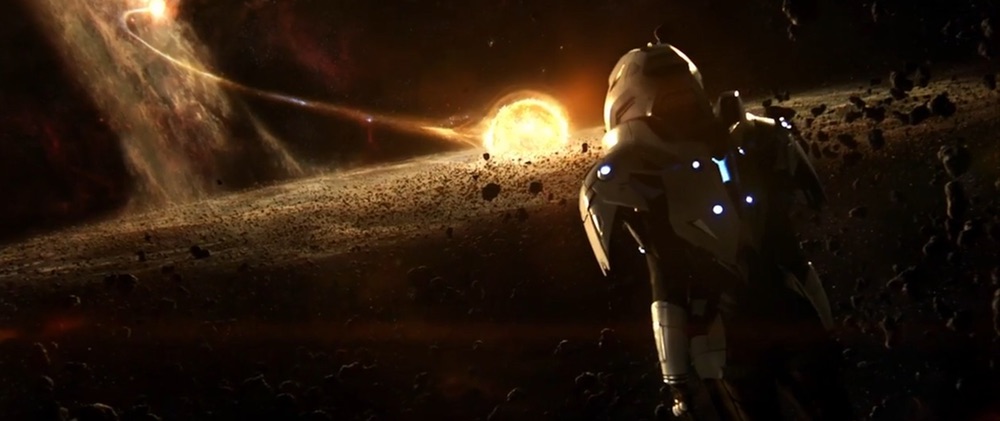
How 'Star Trek: Discovery' Warps Science

This article was originally published at The Conversation. The publication contributed the article to Space.com's Expert Voices: Op-Ed & Insights.
I've been alive for 44 years, and I've been watching Star Trek for 44 years.
I was a baby sitting on my father's lap for re-runs of the original series. I watched Star Trek: The Motion Picture and Star Trek II: The Wrath of Khan at the drive-in. And on I watched, through another 11 films and 624 television episodes, and finally, this month, to the brand new Star Trek: Discovery.
Yes, I'm a Trekkie.
Star Trek is set in space. At its very heart, it aims to be a story of exploration, of advancing knowledge, of science. Or to quote the show's original creator, Gene Roddenberry himself, the continuing mission of Star Trek is "to explore strange new worlds … to boldly go where no one has gone before."
But despite its claims, Star Trek is not really a show about science. Star Trek is at its finest when it explores the human condition, and when it sets a standard for what we aspire to be.
Strange new worlds aren't like Star Trek's
While Star Trek makes a passionate case that science and technology can bring us peace and prosperity, it often also presents an optimistic and simplified view of our current best scientific understanding.
Get the Space.com Newsletter
Breaking space news, the latest updates on rocket launches, skywatching events and more!
Some of the very first scenes from the newest series, Star Trek: Discovery, illustrate this. Capt. Philippa Georgiou and Cmdr. Michael Burnham walk together under open skies on a desert planet. It is not especially bold to predict this will be the first of many more such "away missions" as the series develops. What an astronomer would give for this to be true! But sadly, even desolate desert planets are the rarest of the rare.

In the real universe, we now know of more than 3,500 planets around other stars, and not a single one of these is hospitable in the way seen on Star Trek. Gas giants with crushing pressure but no solid surface, planets hot enough to melt lead, and rain storms of molten iron: these are truly the strange new worlds that await us.
While it's perhaps just a matter of a few more years before we begin to find planets that deserve the title "Earth-like," worlds with normal gravity, breathable air, bearable temperatures and safe levels of radiation will remain exceedingly rare. Heading down to the surface for a stroll and a look around will seldom occur, and not before a great deal of careful study and testing.
Folly of research and exploration
Another Star Trek anomaly for me is that many episodes begin with the crew carrying out a scientific study of a star, a nebula, or some other cosmic phenomenon. Normally, some emergency promptly calls them away from their research even before we get to the opening credits. Pity the poor 24th century PhD student whose work will now never be completed!
The implication is that the quotidian activities of Federation starships involve a lot of galactic fieldwork. However, I can't think of anything more inefficient than sending a ship full of fragile humanoids out to study an astrophysical object in person. If there is one thing that modern astronomy has exquisitely shown us, it’s that we can learn stupendous amounts with powerful telescopes, and even more when we dispatch robotic probes. It's simply not necessary to visit an object ourselves in order to deeply understand it.
Of course, I'm not really a curmudgeon, and this is only a TV show. There are stories to tell, adventures to be had, and a galaxy to explore. Indeed, for me, one of the most memorable scenes from the first episode of Star Trek: Discovery was the binary star system where much of the action takes place.

The USS Shenzhou parks itself alongside the spectacular tableau of two stars captured by each other's gravity, around each of which newborn planets are slowly forming from gas and dust. Beautiful and wonderful! (And I note that, at least this time, the heroes were not there to perform an astrophysical study, but to perform the far more practical task of repairing an "interstellar relay.")
Inspiration spurs education
Ultimately, Star Trek presents us with a paradox. On the one hand, it continues to serve as an inspiration for young people to pursue their own dreams of exploration, leading them to rewarding careers in science, technology and engineering.
On the other hand, most of the science of Star Trek simply doesn't make sense: it's at best a wild extrapolation of what we know, but more often it's a jumble of technobabble and pure fancy.
You might argue that Trekkie scientists like me are victims of a cosmic bait-and-switch, lured into careers of real science with all of its limitations, by the impossible promises of warp drive, alien encounters and teleportation.
So, why does Star Trek work? Why has it endured for more than 50 years, and why do many hard-nosed scientists, like me, love it so much? Because many of the promises that Star Trek make are very possible indeed.
Star Trek promises that seemingly unknowable things will one day be knowable, that there are better ways of doing things than the way we do them now, and that a team of diverse individuals, focused together on a greater goal, can accomplish just about anything.
Star Trek, at its heart, captures what science is all about.
Bryan Gaensler, Director, Dunlap Institute for Astronomy and Astrophysics, University of Toronto
This article was originally published on The Conversation. Read the original article. Follow all of the Expert Voices issues and debates — and become part of the discussion — on Facebook, Twitter and Google +. The views expressed are those of the author and do not necessarily reflect the views of the publisher. This version of the article was originally published on Space.com.
Join our Space Forums to keep talking space on the latest missions, night sky and more! And if you have a news tip, correction or comment, let us know at: community@space.com.









